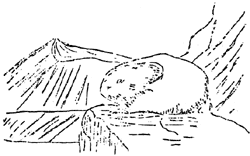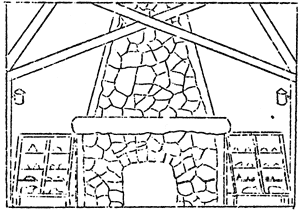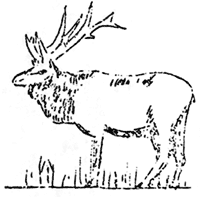Conies
By Charlie Croghan, Ranger
In spite of the fact that conies are usually very timid and seclusive animals, this season they are becoming somewhat accustomed to the nearness of visitors at Crater Lake.

They may be seen busily engaged in carrying and storing their winter supply of forage at the foot of the new trail during the quieter moments between launch trips, giving observing passers-by a rare opportunity to study them. These exceedingly interesting little animals do not hibernate in the winter as do ground squirrels and marmots. Owing to the fact that their homes are deeply burried with snow seven or eight months of the year, they are busy during the short summer season laying up prodigious stores of grasses and other vegetation to be used as hay during the long winter. Among themselves they are very sociable, communicating with each other along the rocky pathways beneath the snow in the winter-time.
Notes on Three Amphibians
By Berry Campbell
At the foot of the new trail to the Lake, three species of amphibians were found on July 1, 1929. The first was the Longtoed Salamander, Ambystoma macrodactylum. This is a chocolate colored lizard-like animal, about four inches long, with a bright wheat stripe down its back from its neck to the tip of its tail. On its head are several more blotches of wheat. The adults are abundant under the rocks at the shore of the Lake, while in the small bays and pools, the larvae may be seen swimming about.
The Pacific Water Dog was also found. All of those seen were just losing their gills and metamorphosing into adult salamanders and, consequently, they were not as large as one would ordinarily find them. Those measured three and one-half or four inches but they grow to be twice that long. They may be recognized by their light orange stomachs and by their rough skin. The Water Dog is found along the whole Pacific Coast from Southern California to British Columbia.
The third amphibian was the Northwestern toad, Pufo boreas boreas. The specimen that we found was a young one, about two inches long; the ordinary length is about four or five inches. These toads may be recognized at once by the warts on their skin and the white stripe down their backs. They are found all over northwestern United States.
Poison!
By F. Lyle Wynd
The False Green Hellebore (Veratrum viride Ait.) is blooming in profusion on the camp ground at the Rim. Its large green leaves cause tourists to frequently mistake it for skunk cabbage.
The Hellebores have long been know to be very poisonous. All parts of the plant are lethal. As far back as the time of Pliny the deadly properties of this genus of plants were know. Pliny himself tells us how oxen, horses, and swine were killed by eating the foliage. On our own Pacific Coast, far from the time and place of Pliny, there is considerable loss among foraging stock when the grazing is short. The fine green leaves are very tempting to animals, although it is rare that they will eat them unless pressed by hunger.
The number of poisonous substances in the tissues of the Hellebores is very large indeed. Of these the so-called “veratrin” having the chemical formulae C32H19NO11, has a violent physiological effect. It causes severe sneezing and dilates the pupils of the eyes. Recently this substance has been reduced to several which were unknown to the earlier investigators. Of these the base, “cevadin”, is very toxic. “Veratridin” and “sabadillin” have also been separated from the “veratrin” of the earlier writers. There have been many other poisonous bases, alkaloids, and glucosides found in these plants by toxicologists.
Most cased of poisoning from this plant are due to over doses of the drug made from them.
The Indians used this plant as an emitic.
Crater Lake Museum Notes
By Miss Mable Hibbard, Ranger Naturalist
We are happy to announce the receipt of several donations for the Natural History Library in the museum. As the Government makes no appropriation for the purchase of books for library use these expressions of generosity are very much appreciated.
The collection of rock specimens has been increased with materials from many of the interesting lava flows about the Lake.
Study skins of the Bushy-tailed Woodrat and both adult and immature marmot have been added to the mammal case.
The only reptile heretofore collected in the Park is the Mountain Garter Snake, found by Dr. Loye Miller in July, 1926. Sections of the skin cast of two others have now been brought in from Wizard Island, and the presence of a live garter snake has been reported recently by one of the workmen.
A collection of insects injurious to the forest trees of the Park is almost ready to install in the wall cases which now contain the most representative specimens of the region.
One of the most popular features of the museum is the cut wild flower exhibit which totals over one hundred twenty-five specimens. Here visitors can identify at close range the flowers which they have seen in the Park, whether along the roadside, trail or in the numerous meadows.
The daily visitors to the museum usually number over two hundred. This attendance is an encouraging indication of increasing interest in museum exhibits.
Elk
By Earl U. Homuth
The interest of tourists is always aroused by the animals of our National Parks. Elk are not native in the region of Crater Lake, but recently several herds have been reported from the east side along the Rim Road. During future years Elk may become a regular attraction to visitors.
A herd of these animals was brought to Oregon from Jackson Hole country of Wyoming, by the State Game Commission. They were kept for a time in a game farm, and later distributed to various parts of the state. About twelve head were placed in Klamath County, east of Crater Lake, in 1913. This small herd has increased and now numbers over two hundred which have spread throughout the Cascade Range in this vicinity.
Three separate herds are known to be roaming about the Crater Lake region, one near Mount McLoughlin and one near Red Blanket, toward the south, both being outside the Park area, although the latter is reported occasionally within the south boundary. The third group is found about the slopes of Scott Peak. This is the herd which has been observed this season.
***previous*** — ***next***




